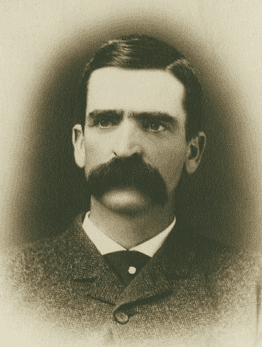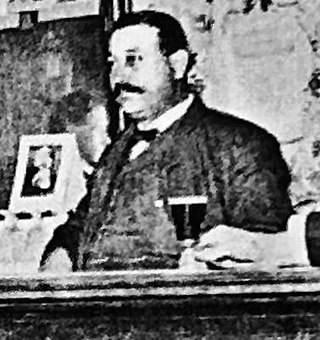
Pterocarpus is a pantropical genus of trees in the family Fabaceae. It belongs to the subfamily Faboideae, and was recently assigned to the informal monophyletic Pterocarpus clade within the Dalbergieae. Most species of Pterocarpus yield valuable timber traded as padauk, usually pronounced or ; other common names are mukwa or narra. The west African species may be traded as African rosewood. P. santalinus also yields the most precious red sandalwood in China known as Zitan. The wood from the narra tree and the Burmese padauk tree is marketed as amboyna when it has grown in the burl form. The scientific name is Latinized Ancient Greek and means "wing fruit", referring to the unusual shape of the seed pods in this genus.

Deadwood is a city that serves as county seat of Lawrence County, South Dakota, United States. It was named by early settlers after the dead trees found in its gulch. The city had its heyday from 1876 to 1879, after gold deposits had been discovered there, leading to the Black Hills Gold Rush. At its height, the city had a population of 25,000, attracting Old West figures such as Wyatt Earp, Calamity Jane, and Wild Bill Hickok.

Pinus elliottii, commonly known as slash pine, is a conifer tree native to the Southeastern United States. Slash pine is named after the "slashes" – swampy ground overgrown with trees and bushes – that constitute its habitat. Other common names include swamp pine, yellow slash pine, and southern Florida pine. Slash pine has two different varieties: P. e. var. elliottii and P. e. var. densa. Historically, slash pine has been an important economic timber for naval stores, turpentine, and resin. The wood of slash pine is known for its unusually high strength, especially for a pine. It exceeds many hardwoods and is even comparable to very dense woods such as ironwood.

Pinus ponderosa, commonly known as the ponderosa pine, bull pine, blackjack pine, western yellow-pine, or filipinus pine is a very large pine tree species of variable habitat native to mountainous regions of western North America. It is the most widely distributed pine species in North America.

Ian David McShane is a British actor. He is known for his television performances, particularly as the title role in the BBC series Lovejoy (1986–1994), Al Swearengen in Deadwood (2004–2006) and its 2019 film continuation, as well as Mr. Wednesday in American Gods (2017–2021). For the original series of Deadwood, McShane won the Golden Globe Award for Best Actor – Television Series Drama and received a nomination for the Primetime Emmy Award for Outstanding Lead Actor in a Drama Series. For the film, he was nominated for the Primetime Emmy Award for Outstanding Television Movie.

Deadwood is an American Western television series that aired on the premium cable network HBO from March 21, 2004, to August 27, 2006, spanning three seasons and 36 episodes. The series is set in the 1870s in Deadwood, South Dakota, before and after the area's annexation by the Dakota Territory, and charts Deadwood's growth from camp to town. The show was created, produced, and largely written by David Milch. Deadwood features a large ensemble cast headed by Timothy Olyphant and Ian McShane, playing the real-life Deadwood residents Seth Bullock and Al Swearengen, respectively. Many other historical figures appear as characters, including George Crook, Wyatt Earp, E. B. Farnum, George Hearst, Wild Bill Hickok, Calamity Jane, Sol Star, A. W. Merrick, Jack McCall, and Charlie Utter. The plot lines involving these characters include historical truths as well as substantial fictional elements. Milch used actual diaries and newspapers from 1870s Deadwood residents as reference points for characters, events, and the look and feel of the show.

Seth Bullock was a Canadian-American frontiersman, business proprietor, politician, sheriff, and U.S. Marshal. He was a prominent citizen in Deadwood, South Dakota, where he lived from 1876 until his death, operating a hardware store and later a large hotel, the Bullock Hotel.

Ellis Alfred Swearengen was an American pimp and entertainment entrepreneur who ran the Gem Theater, a notorious brothel, in Deadwood, South Dakota, for 22 years during the late 19th century.

Pseudevernia furfuracea, commonly known as tree moss, is a lichenized species of fungus that grows on the bark of firs and pines. The lichen is rather sensitive to air pollution, its presence usually indicating good air conditions in the growing place. The species has numerous human uses, including use in perfume, embalming and in medicine. Large amounts of tree moss is annually processed in France for the perfume industry.
The Black Hills gold rush took place in Dakota Territory in the United States. It began in 1874 following the Custer Expedition and reached a peak in 1876–77.

Leratiomyces ceres, commonly known as the chip cherry or redlead roundhead, is mushroom which has a bright red to orange cap and dark purple-brown spore deposit. It is usually found growing gregariously on wood chips and is one of the most common and most distinctive mushrooms found in that habitat. It is common on wood chips and lawns in North America, Europe, Australia, New Zealand and elsewhere. The name Stropharia aurantiaca has been used extensively but incorrectly for this mushroom.

Salix lasiolepis is a species of willow native to western North America.

Psilocybe caerulipes, commonly known as blue-foot, is a rare psilocybin mushroom of the family Hymenogastraceae, having psilocybin and psilocin as main active compounds. An older synonym is Agaricus caerulipes.

Oudenone is a molecule found in fungus metabolism. It is an inhibitor of the enzyme tyrosine hydroxylase.

The Black Hills is an isolated mountain range rising from the Great Plains of North America in western South Dakota and extending into Wyoming, United States. Black Elk Peak, which rises to 7,244 feet (2,208 m), is the range's highest summit. The Black Hills encompass the Black Hills National Forest. The name of the hills in Lakota is Pahá Sápa. The Black Hills are considered a holy site. The hills are so called because of their dark appearance from a distance, as they are covered in evergreen trees.

Oudemansiella australis is a species of gilled mushroom in the family Physalacriaceae. It is found in Australasia, where it grows on rotting wood. It produces fruit bodies that are white, with caps up to 5.5 cm (2.2 in) in diameter, attached to short, thick stems.

Oudemansiella is a genus of fungi in the family Physalacriaceae. The genus contains about 15 species that are widely distributed in tropical and temperate regions. Yang and colleagues revised the genus in a 2009 publication, describing several new species and several varieties. They classified species in the genus into four sections based on the structure of the cap cuticle: Oudemansiella, Mucidula, Dactylosporina, and Radicatae.

Oudemansiella mucida, commonly known as porcelain fungus, is a basidiomycete fungus of the family Physalacriaceae and native to Europe.

Hymenopellis is a genus of fungi in the family Physalacriaceae. The genus was described by mycologist Ron Petersen in 2010. The type species is Hymenopellis radicata, originally described by British botanist Richard Relhan in 1780 as Agaricus radicatus.
















